Most popular from web right now
An archaeological mystery in a half-ton lead coffin
 In the ruins of a city that was once Rome's neighbor, archaeologists last summer found a 1,000-pound lead coffin. Who or what is inside is still a mystery, said Nicola Terrenato, the University of Michigan professor of classical studies who leads the project---the largest American dig in Italy in the past 50 years.
In the ruins of a city that was once Rome's neighbor, archaeologists last summer found a 1,000-pound lead coffin. Who or what is inside is still a mystery, said Nicola Terrenato, the University of Michigan professor of classical studies who leads the project---the largest American dig in Italy in the past 50 years."We're very excited about this find," Terrenato said. "Romans as a rule were not buried in coffins to begin with and when they did use coffins, they were mostly wooden. There are only a handful of other examples from Italy of lead coffins from this age---the second, third or fourth century A.D. We know of virtually no others in this region."
This one is especially unusual because of its size.
"It's a sheet of lead folded onto itself an inch thick," he said. "A thousand pounds of metal is an enormous amount of wealth in this era. To waste so much of it in a burial is pretty unusual."
Was the deceased a soldier? A gladiator? A bishop? All are possibilities, some more remote than others, Terrenato said. Researchers will do their best to examine the bones and any "grave goods" or Christian symbols inside the container in an effort to make a determination.
"It's hard to predict what's inside, because it's the only example of its kind in the area," Terrenato said. "I'm trying to keep my hopes within reason."
Human remains encased in lead coffins tend to be well preserved, if difficult to get to. Researchers want to avoid breaking into the coffin. The amount of force necessary to break through the lead would likely damage the contents. Instead, they will first use thermography and endoscopy. Thermography involves heating the coffin by a few degrees and monitoring the thermal response. Bones and any artifacts buried with them would have different thermal responses, Terrenato said. Endoscopy involves inserting a small camera into the coffin. But how well that works depends on how much dirt has found its way into the container over the centuries.
If these approaches fail, the researchers could turn to an MRI scan---an expensive option that would involve hauling the half-ton casket to a hospital.
The dig that unearthed this find started in summer 2009 and continues through 2013. Each year, around 75 researchers from around the nation and world, including a dozen U-M undergraduate students, spend two months on the project at the ancient city of Gabii (pronounced "gabby").
The site of Gabii, situated on undeveloped land 11 miles east of Rome in modern-day Lazio, was a major city that pre-dates Rome but seems to have waned as the Roman Empire grew.
Studying Gabii gives researchers a glimpse into pre-Roman life and offers clues to how early Italian cities formed. It also allows them broader access to more substantial archaeological layers or strata. In Rome, layers of civilization were built on top of each other, and archaeologists are not able or allowed to disturb them.
"In Rome, so often, there's something in the way, so we have to get lucky," Terrenato said. "In Gabii, they should all be lucky spots because there's nothing in the way."
Indeed, Terrenato and others were surprised to find something as significant as this coffin so soon.
"The finding of the lead coffin was exhilarating," said Allison Zarbo, a senior art history major who graduates this spring.
Zarbo didn't mind that after the researchers dug up the coffin once, they had to pile the dirt back on to hide it from looters overnight.
"The fact that we had to fill the hole was not so much of a burden as a relief!" Zarbo said. "For academia to lose priceless artifacts that have been found fully in context would be very damaging to our potential knowledge."
Students spent most of their time pick-axing, shoveling, and manning the wheelbarrows, said Bailey Benson, a junior who is double majoring in classical archaeology and art history.
"By the end of the day, not even a 20-minute shower can remove all the dirt and grime you get covered in," Benson said. "It's hard but satisfying work. How many people can say they uncovered an ancient burial?"
April 8, 2010 at 5:27 AM
It's clear the coffin has already been breached.
Why not just carefully evacuate the dirt from the open end?
Post a Comment
Post a Comment